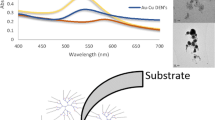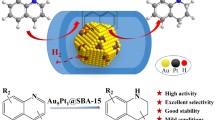Abstract
Poly(methacryloyloxy quinoline) microparticles were synthesized and used as reducing and stabilizing agents to prepare Au/Pt bimetallic nanoparticle (NP) decorated microparticle (MP) hybrid catalyst systems. These newly reported hybrid catalyst systems were used for reduction of styrene into ethylbenzene. Gold precursor was essential to prepare bimetallic NPs due to its great interaction with PMAQ resulting in the reduction to AuNPs on the surface of PMAQ MPs. Pt is also contrubute to NP formation thanks to this superior interaction between Au and PMAQ MPs. The bimetallic nanoparticle contents on the PMAQ MPs were determined as Au0.85Pt0.15 via XRD analysis. Au and Pt amounts were also determined with ICP-MS analysis. Although the metal amount in the sample was quite low, the catalytic effect was remarkable for hybrid system. AuNP decorated MPs had no catalytic activity for the reduction of styrene. Thus, it is clear that Pt was the active part of hybrid catalyst system for this reaction. On the other hand, gold precursor had been determined as crucial for the simultaneous synthesis of bimetallic NP decorated MPs as well.
Graphic Abstract
New microparticles decorated with bimetallic nanoparticles have been synthesized and used effectively as a catalyst systems in the hydrogenation of styrene. While it is reported in the literature that such particles have successful catalytic activity in various oxidations, our particles stand out with reducing activities, reusabilities and easy production/removal properties.





Similar content being viewed by others
References
Sherrington DC (1988) Polymer-supported metal-complex oxidation catalysis. React Polym 9(1):131–131
Li H, He BL (1998) Polymer support effects of metal complexes for catalysis. Chin J Polym Sci 16(4):362–369
Zou Z, Jiang Y, Song K (2020) Pd nanoparticles assembled on metalporphyrin-based microporous organic polymer as efficient catalyst for tandem dehydrogenation of ammonia borane and hydrogenation of nitro compounds. Catal Lett 150:1277–1286
Li YH, Li JY, Yi-Jun Xu (2021) Bimetallic nanoparticles as cocatalysts for versatile photoredox catalysis. EnergyChem 3(1):100047
Begum R, Farooqi ZH, Naseem K et al (2018) Applications of UV/Vis spectroscopy in characterization and catalytic activity of noble metal nanoparticles fabricated in responsive polymer microgels: a review. Crit Rev Anal Chem 48(6):503–516
Kocak G, Solmaz G, Dikmen Z, Butun V (2018) Preparation of cross-linked micelles from glycidyl methacrylate based block copolymers and their usages as nanoreactors in the preparation of gold nanoparticles. J Polym Sci 56(5):514–526
Ulker D, Kocak G, Tuncer C, Butun V (2019) Preparation of monometallic and bimetallic alloy nanoparticles stabilized with sulfobetaine-based block copolymer and their catalytic activities. Colloid Polym Sci 297(7–8):1067–1078
Liu Y, Zhang KH, Li WY, Ma JH, Vancso GJ (2018) Metal nanoparticle loading of gel-brush grafted polymer fibers in membranes for catalysis. J Mater Chem A 6(17):7741–7748
Rout L, Mohan A, Thomas AM, Ha CS (2020) Rational design of thermoresponsive functionalized MCM-41 and their decoration with bimetallic Ag-Pd nanoparticles for catalytic application. Microporous Mesoporous Mater 291:109711
Xu Y, Yao YX, Yu HT et al (2019) Nanoparticle-encapsulated hollow porous polymeric nanosphere frameworks as highly active and tunable size-selective catalysts. ACS Macro Lett 8(10):1263–1267
Jang W, Taylor R, Eyimegwu PN, Byun H, Kim JH (2019) In situ formation of gold nanoparticles within a polymer particle and their catalytic activities in various chemical reactions. ChemPhysChem 20(1):70–77
Chakrabartty S, Gopinath CS, Raj CR (2017) Polymer-based hybrid catalyst of low Pt content for electrochemical hydrogen evolution. Int J Hydrog Energy 42(36):22821–22829
Fu JW, Wang SM, Zhu JH et al (2018) Au-Ag bimetallic nanoparticles decorated multi-amino cyclophosphazene hybrid microspheres as enhanced activity catalysts for the reduction of 4-nitrophenol. Mater Chem Phys 207:315–324
Udumula V, Tyler JH, Davis DA et al (2015) Dual optimization approach to bimetallic nanoparticle catalysis: impact of M-1/M-2 ratio and supporting polymer structure on reactivity. ACS Catal 5(6):3457–3462
Zaleska-Medynska A, Marchelek M, Diak M, Grabowska E (2016) Noble metal-based bimetallic nanoparticles: the effect of the structure on the optical, catalytic and photocatalytic properties. Adv Colloid Interface 229:80–107
Bronstein LM, Chernyshov DM, Volkov IO et al (2000) Structure and properties of bimetallic colloids formed in polystyrene-block-poly-4-vinylpyridine micelles: catalytic behavior in selective hydrogenation of dehydrolinalool. J Catal 196(2):302–314
Xu N, Meng L, Li HW, Lu DY, Wu YQ (2018) Polyethyleneimine capped bimetallic Au/Pt nanoclusters are a viable fluorescent probe for specific recognition of chlortetracycline among other tetracycline antibiotics. Microchim Acta. https://doi.org/10.1007/s00604-018-2828-0
Dwivedi C, Chaudhary A, Srinivasan S, Nandi CK (2018) Polymer stabilized bimetallic alloy nanoparticles: synthesis and catalytic application. Colloid Interface Sci 24:62–67
Zhang HJ, Toshima N (2013) Synthesis of Au/Pt bimetallic nanoparticles with a Pt-rich shell and their high catalytic activities for aerobic glucose oxidation. J Colloid Interface Sci 394:166–176
Shim K, Lee WC, Heo YU et al (2019) Rationally designed bimetallic Au@Pt nanoparticles for glucose oxidation. Sci Rep 9:894
Tan C, Sun Y, Zheng J et al (2017) A self-supporting bimetallic Au@Pt core-shell nanoparticle electrocatalyst for the synergistic enhancement of methanol oxidation. Sci Rep 7:6347
Xie YX, Dimitrov N (2020) Ultralow Pt loading nanoporous Au-Cu-Pt thin film as highly active and durable catalyst for formic acid oxidation. Appl Catal B 263:118366
McKeown CRFMF (2017) Pt-Au film catalyst for formic acid oxidation. Procedia Eng 215:211–218
Dikmen Z, Javanifar R, Bütün V (2020) Fluorescent poly(methacryloxy quinolin) microparticles allowing simultaneous gold detection with additive-free photocatalytic synthesis of raspberry-like gold nanoparticles and gold nanoparticle decorated microparticles. Eur Polym J 129:109623
de Vries WC, Niehues M, Wissing M et al (2019) Photochemical preparation of gold nanoparticle decorated cyclodextrin vesicles with tailored plasmonic properties. Nanoscale 11(19):9384–9391
Belhout SA, Baptista FR, Devereux SJ, Parker AW, Ward AD, Quinn SJ (2019) Preparation of polymer gold nanoparticle composites with tunable plasmon coupling and their application as SERS substrates. Nanoscale 42:19884–19894
Han J, Liu Y, Guo R (2009) Reactive template method to synthesize gold nanoparticles with controllable size and morphology supported on shells of polymer hollow microspheres and their application for aerobic alcohol oxidation in water. Adv Funct Mater 19(7):1112–1117
Zhang GR, Zhao D, Feng YY et al (2012) Catalytic Pt-on-Au nanostructures: why Pt becomes more active on smaller Au particles. ACS Nano 6(3):2226–2236
Khalil AA (2011) Synthesis, exchange reactions, and biological activity of Poly(8-methacryloxyquinoline). J Appl Polym Sci 121(2):1160–1165
Fedorczyk A, Pomorski R, Chmielewski M, Ratajczak J, Kaszkur Z, Skompska M (2017) Bimetallic Au@Pt nanoparticles dispersed in conducting polymer—a catalyst of enhanced activity towards formic acid electrooxidation. Electrochim Acta 246:1029–1041
Author information
Authors and Affiliations
Corresponding author
Additional information
Publisher's Note
Springer Nature remains neutral with regard to jurisdictional claims in published maps and institutional affiliations.
Rights and permissions
About this article
Cite this article
Dikmen, Z., Ünver, H. & Bütün, V. Au/Pt Bimetallic Nanoparticle Decorated Microparticle Hybrid Catalyst System for Heterogeneous Hydrogenation of Styrene. Catal Lett 151, 3656–3663 (2021). https://doi.org/10.1007/s10562-021-03599-4
Received:
Accepted:
Published:
Issue Date:
DOI: https://doi.org/10.1007/s10562-021-03599-4




